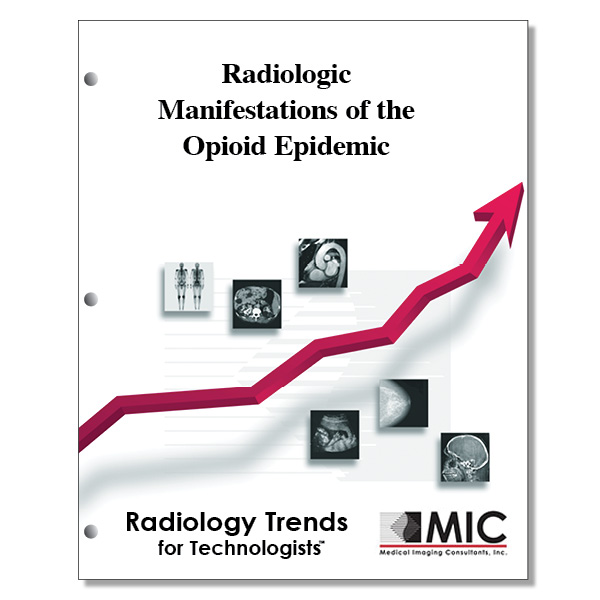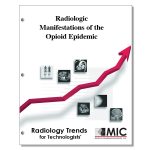

Radiologic Manifestations of the Opioid Epidemic
A presentation of the imaging findings of many conditions and complications associated with the current epidemic of opioid use in the U.S.
Course ID: Q00567 Category: Radiology Trends for Technologists Modalities: CT, MRI, Radiography, Vascular Interventional2.0 |
Satisfaction Guarantee |
$24.00
- Targeted CE
- Outline
- Objectives
Targeted CE per ARRT’s Discipline, Category, and Subcategory classification:
[Note: Discipline-specific Targeted CE credits may be less than the total Category A credits approved for this course.]
Computed Tomography: 1.00
Procedures: 1.00
Head, Spine, and Musculoskeletal: 0.25
Neck and Chest: 0.50
Abdomen and Pelvis: 0.25
Magnetic Resonance Imaging: 2.00
Image Production: 0.25
Data Acquisition, Processing, and Storage: 0.25
Procedures: 1.75
Neurological: 0.75
Body: 0.75
Musculoskeletal: 0.25
Registered Radiologist Assistant: 1.75
Procedures: 1.75
Abdominal Section: 0.50
Thoracic Section: 0.25
Musculoskeletal and Endocrine Sections: 0.25
Neurological, Vascular, and Lymphatic Sections: 0.75
Outline
- Introduction
- Neuroradiologic Manifestations
- Cerebral Septic Emboli
- Cerebritis, Brain Abscess, and Ventriculitis
- Mycotic Aneurysm
- Heroin-induced Leukoencephalopathy
- Hypoxic Ischemic Injury
- Cardiopulmonary Manifestations
- Infective Endocarditis
- Septic Pulmonary Emboli
- Pulmonary Artery Mycotic Aneurysm
- Noncardiogenic Pulmonary edema and Acute Lung Injury
- Musculoskeletal Manifestations
- Soft-Tissue Infections
- Retained Needle Fragments
- Rhabdomyolysis and Overdose
- Abdominal Manifestations
- Intracorporeal Concealment of Drugs
- Embolic Infarcts in Abdominal Viscera
- Mycotic Aneurysm of the Superior Mesenteric Artery
- Conclusion
Objectives
Upon completion of this course, students will:
- state the number of opioid overdose deaths in 2015
- list the areas of the body where cross-sectional imaging helps determine pathology
- recall possible complications associated with dislodgement of infected cardiac vegetations followed by intracranial vessel occlusion
- discuss the Wilbring et al. study of 495 patients
- choose which MR sequence is most sensitive for the detection of hyperintensity in the subarachnoid spaces
- state the portion of the body that preserves the blood-brain barrier
- list the stages of abscess development
- describe pyogenic ventriculitis
- list the reasons why drug abusers lick the needle before using it for injection
- recall the amount of intravenous drug users that admit to licking the needle prior to injecting drugs
- state the modality of choice for imaging mycotic aneurysm
- recognize the possible complications to vessel rupture due to aneurysm
- state the mortality rate associated with a ruptured mycotic aneurysm
- recall the moniker associated with heroin-induced leukoencephalopathy
- state the imaging modality that most conspicuously identifies the acute phase of toxic encephalopathy
- discuss imaging pitfalls and findings that emergency radiologists should be familiar with in the setting of opioid overdose patients
- state the increase in the estimated incidence of infective endocarditis in the general population
- chose the imaging procedure that should be utilized for initial evaluation of clinically suspected infective endocarditis
- recall the imaging procedure that has the highest sensitivity for the detection of native valve endocarditis
- list the clinical symptoms of septic pulmonary emboli
- list the most common CT features of septic pulmonary emboli
- recall the mortality rate for patients with pulmonary artery mycotic aneurysm
- describe how pulmonary artery mycotic aneurysms are managed
- explain the term “pocket shot”
- state the most common reason for hospital admission of intravenous drug users
- list areas in the body where needle fragments may be found
- state the possible cause of cardiac rhabdomyolysis
- describe “body-packer syndrome”
- explain where packaged drugs may be concealed within the body
- list the areas of the body that may be affected by the release of septic emboli associated with left-sided endocarditis
